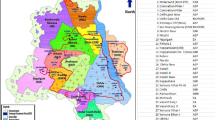Abstract
In this paper limnological status of river Suswa was observed for a period of two years. A water quality Beck modified Khanna Bhutiani model (BMKB model) was developed to calculate DO (dissolved Oxygen) and BOD (biochemical oxygen demand). The model was developed to calculate DO and BOD by using DO/BOD of same place and upstream in previous season which results in Single output. This model gives the seasonal value on the basis of previously taken upstream and downstream observations/concentrations of DO and BOD. The model was calibrated and verified for the water quality data (Physico-chemical data) of samples collected from river Suswa in different seasons. The model gave good agreement between data observed by it and the data observed manually, thus substantiating the validity of the model. Only minor differences were observed in physical, chemical and heavy metals of all the four sampling stations during the course of study.
Similar content being viewed by others
References
APHA, AWWA, WPCF. (1998). Standard methods for the examination of water and wastewater. 20th ed. New York, Washington D.C.
Badola, S.P., & Singh, H.R. (1981). Hydrobiology of the river Alaknanda of Garhwal Himalaya. Indian Journal of Ecology, 8 (2), 269–276.
Beck, M.B. (1974). Maximum likelihood identification applied to DO-BOD-algae models for a fresh water stream, Report 7431(C). Sweden: Lund Institute of Technology, Division of automatic control.
Bilgrami, K.S., & Duttamunshi, J.S. (1985). Ecology of river Ganges (Patna Farrakka). Technical report, CSIR.
Biswas, A.K. (1981). Models for water quality management. New York: McGraw-Hill Company.
Chopra, A.K., & Patrick Nirmal, J. (1994). Effect of domestic sewage on self-purification of Ganga water at Rishikesh I. Physicochemical parameters. Advance Biology, 13, 75–82.
David, A. (1956). Studies on the pollution of the Bhadra river at Badrawati fisheries effluents. Proceedings of National Inititute Set. India, 93, 132–160.
Giordano, F.R., Weir, M.D., & Fox, W.P. (1997). A first course in mathematical Modeling. 2nd ed. Brooks/Cole Publishing company, pp. 1–525.
Grimsrud, G.P., Finnemore, E.J., & Owen, H.J. (1976). Evaluation of water quality models – A management guide for planners, EPA 600/5-76-004. Washington, D.C.: U.S. Environmental Protection Agency, pp. 21–35.
James, A. (1993). Ed. An introduction to water quality modeling. England: John Wiley and Sons, west Sussex.
Karim, M.R., & Badruzzaman, A.B.M. (1999). Modeling of Nutrient transport and dissolved oxygen in the water column in river system. Pollution research, 18, 195–206.
Khanna, D.R. (1993). Ecology and pollution of Ganga River. Delhi: Ashish Publication House, 1–241.
Khanna, D.R., Badola, S.P., & Dobriyal, A.K. (1993). Plankton ecology of the river Ganga at Chandighat, Haridwar, Advances in limnology. In Singh, H. R. (ed.), New Delhi: Narendra Publishing house, pp. 171–174.
Lloyd, R. (1961). The toxicity of mixture of zinc and copper sulphate to rain bow trout (Salmogaidnerii) Richardson. Ann Appied Biology, 49, 535–538.
Masch, F.D., & Associates. (1970). QUALI, Simulation of water quality in streams and canals, program documentation and user's manual., Report to Texas water development Board, Austin, Texas.
Mohanty, R.C. (1981). Water quality studies of some water bodies of Bhubaneshwar, Ph.D. Thesis. Utkal University, pp. 1–240.
Morley Donald, A. (1979). Mathematical modeling in water and wastewater treatment. London: Applied Science Publishers Ltd., pp. 1–366.
Orlob, G.T. (1983). Mathematical modeling of water quality: Streams, lakes and reservoirs. John Wiley & Sons, pp. 1–518.
Pahwa, D.V., & Mehrotra, S.M. (1966). Observations on fluctuations in abundance of plankton in relation to certain hydrological conditions of river Ganga. Proceedings of National Academy of Science, 36B, 157–189.
Reddy, P.M., & Venkateshwarlu, V. (1987). Assessment of water quality and pollution in the river Tungbhadra near Kurnool, (A.P.). Journal of Environmental Biology, 8, 109–119.
Rutherford, J.C., Scarsbrook, M.R., & Broekhuizen, N. (2000). Grazer control of stream algae: Modeling temperature and flood effects. Journal of Environment Engineering, 331–339.
Singh, H.P., Choudhry, M., & Kalekaur, V. (1982). Seasonal and diurnal changes in physico-chemical features of the river Brahamputra at Guwahati. Indian Journal of Zoology, 2, 77–84.
Venkateshwarlu, T., & Jayanti, T.V. (1968). Hydrobiological studies of the river Sabarmati to evaluate water quality. Hydrobiologia, 33, 442–448.
Verma, S.R., Sharma, P., Tyagi, A., Rani, S., Gupta, A.K., & Dalela, R.C. (1984). Pollution and saprobic status of eastern Kalinadi. Limnologica, 15, 69–133.
Vogler, E.T., & Scherfig, J.S. (2000). Modeling BOD removal in constructed wetlands with mixing cell method. Journal of Environmental Engineering, 125, 782–785.
Welch, P.S. (1948). Limnological methods. Philadelphia: The Blakiston. Co.
Author information
Authors and Affiliations
Corresponding author
Rights and permissions
About this article
Cite this article
Bhutiani, R., Khanna, D.R. Ecological study of river Suswa: modeling DO and BOD. Environ Monit Assess 125, 183–195 (2007). https://doi.org/10.1007/s10661-006-9251-4
Received:
Accepted:
Published:
Issue Date:
DOI: https://doi.org/10.1007/s10661-006-9251-4




